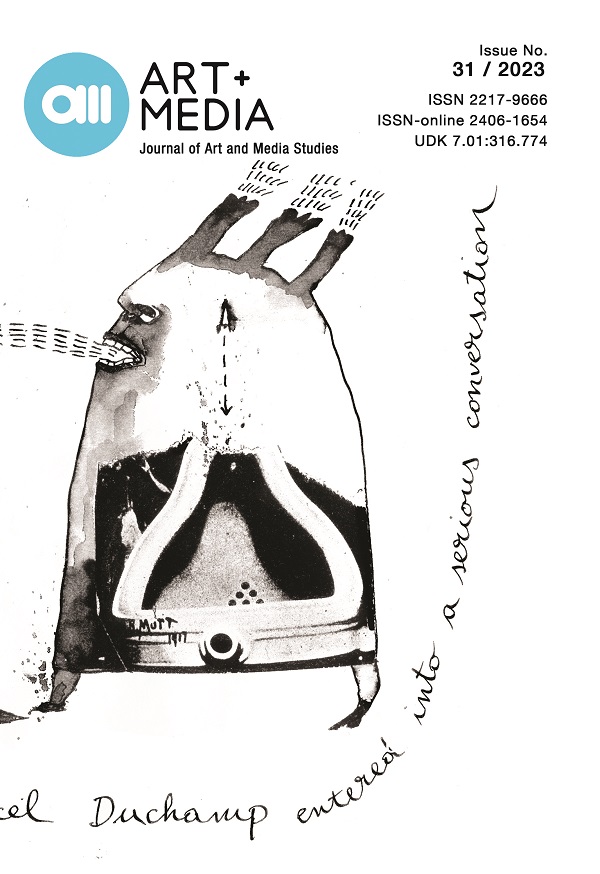Citing the Architecture of the Holocaust as a Method of Critique in Contemporary Artistic Practices: Zbigniew Libera, Zoran Dimovski, and the Use of Scale Models
DOI:
https://doi.org/10.25038/am.v0i29.574Keywords:
architecture of the Holocaust; Auschwitz-Birkenau; contemporary art; scale model; citing; intertextuality.Abstract
This paper presents how visual contemporary art can form intertextual relations to the architecture of the Holocaust. For that purpose, two works are used as examples and analyzed in more detail: Lego. Concentration Camp by Zbigniew Libera (1996) and Diamond Dust by Zoran Dimovski (2021). This paper shows how these artists cite architecture of the Holocaust by scale-modelling and additional elements that give their works complex semantic layers. This paper also includes discussion about invisibility and visibility of concentration and extermination camps, as well as the segment that explains the difference between the use of architectural scale models by the Third Reich propaganda and by contemporary artists. This paper concludes how, when cited in works of contemporary art, architecture becomes a complex sign shifted from one discourse into another and from one historic period to the present, a phenomenon embraced by artists to criticize the socio-political context of its creation, but also to criticize the alarming phenomena of today’s era.
References
Brejzek, Thea and Lawrence Wallen. The Model as Performance Staging Space in Theatre and Architecture. London, New York: Bloomsbury Methuen Drama, 2018. DOI: https://doi.org/10.5040/9781474271417
Buggeln, Marc. “Auschwitz.” Online Encyclopedia of Mass Violence. November 25, 2011. https://www.sciencespo.fr/mass-violence-war-massacre-resistance/en/document/auschwitz.html. Accessed on August 21, 2023
Erll, Astrid and Ann Rigney. “Introduction: Cultural Memory and its Dynamics.” In: Mediation, Remediation, and the Dynamics of Cultural Memory, edited by Astrid Erll and Ann Rigney, 1–11. Berlin: Walter de Gruyter, 2009. DOI: https://doi.org/10.1515/9783110217384.0.1
Feinstein, Stephen C. “Zbigniew Libera’s Lego Concentration Camp: Iconoclasm in Conceptual Art About the Shoah.” Other Voices 2, 1 (February 2000). http://www.othervoices.org/2.1/feinstein/auschwitz.php. Accessed on June 28, 2023
Janisz, Ewa. “Atrocity and Aesthetics. The Politics of Remembering and Representing the Holocaust in Polish Contemporary Art: Zbigniew Libera’s ‘Lego Concentration Camp’.” History of Communism in Europe 6 (2015): 113–134. https://doi.org/10.5840/hce201567 DOI: https://doi.org/10.5840/hce201567
Jankov, Sonja. “Citiranje arhitekture jugoslovenskog modernizma kao stvaralački i interpretativni metod u savremenim umetničkim praksama [Citing architecture of Yugoslav modernism as creative and interpretative method in contemporary art practices].” PhD dissertation, University of Arts in Belgrade, 2021.
Jankov, Sonja. “Architecture as a method of self-location in contemporaneity.” In (De)Construction of Space: Architecture by Other Means, edited by Sonja Jankov and Ivana Markez Filipović, 42–46. Pančevo: Cultural Centre of Pančevo, 2021.
Jaskot, Paul B. Architecture of the Holocaust. United States Holocaust Memorial Museum, Joseph and Rebecca Meyerhoff Annual Lecture. November 4, 2015.
Kötter, Richard and Lewis Preston. “The Planning and Architecture of Deportation, Imprisonment and Death – Reflections on the Ethical Implications of the Holocaust for Built and Natural Environment Disciplines.” International Journal of Humanities and Social Science 8, 11 (November 2018): 1–14. https://doi.org/10.30845/ijhss.v8n11p1 DOI: https://doi.org/10.30845/ijhss.v8n11p1
Kristeva, Julia. “The Bounded Text” (1966–67). In Julia Kristeva, Desire in Language: A Semiotic Approach to Literature and Art, edited by Leon S. Roudiez, 36–63. New York: Columbia University Press, 1980.
Lachmann, Renate. “Mnemonic and Intertextual Aspects of Literature.” In Media and Cultural Memory, edited by Astrid Erll and Ansgar Nünning, 301–310. Berlin, New York: Walter de Gruyter, 2008. DOI: https://doi.org/10.1515/9783110207262.5.301
Mitov, Dejan. “The use of Architectural Scale Models in Populist Representation of Megastructural Projects.” In Situating Populist Politics: Arts & Media Nexus, edited by Milena Dragićević Šešić and Mirjana Nikolić, 213–228. Belgrade: Clio and Faculty of Dramatic Arts – Institute for Theatre, Film, Radio, and Television, 2019.
Piper, Franciszek. “Gas Chambers and Crematoria.” In Anatomy of the Auschwitz Death Camp, edited by Yisrael Gutman and Michal Berenbaum, 157–182. Bloomington and Indianapolis: Indiana University Press, Washington: United States Holocaust Memorial Museum, 1994.
Rigney, Ann. “The Dynamics of Remembrance: Texts Between Monumentality and Morphing.” In Media and Cultural Memory, edited by Astrid Erll and Ansgar Nünning, 345–353. Berlin, New York: Walter de Gruyter, 2008. DOI: https://doi.org/10.1515/9783110207262.5.345
Saltzman, Lisa. “Lost in Translation: Clement Greenberg, Anselm Kiefer, and the Subject of History.” In Visual Culture and the Holocaust, edited by Barbie Zelizer, 74–88. London: The Athlone Press, 2001.
Smith, Albert C. Architectural Model as Machine: A New View of Models from Antiquity to the Present Day. Amsterdam: Elsevier, Architectural Press, 2004.
Smith, Lyn. Remembering: Voices of The Holocaust: A New History in the Words of the Men and Women Who Survived. New York: Carroll & Graf Publishers, 2006.
Sofsky, Wolfgang. The Order of Terror: The Concentration Camp. Translated by William Templer. Princeton, N. J.: Princeton University Press, 1997.
Szenajch, Piotr. “Zbigniew Libera Archive.” COURAGE Registry. http://cultural-opposition.eu/registry/?uri=http://courage.btk.mta.hu/courage/individual/n124188. Accessed on June 27, 2023
Vuković, Stevan. “Svetovi smrti i svet umetnosti [The Worlds of Death and the World of Art]” – catalogue for the exhibition Zoran Dimovski: Gift, Art Gallery, Cultural Centre of Belgrade, March 14 – April 4, 2019. Beograd: Kulturni centar Beograda, 2019.
Waxman, Zoë. Women in the Holocaust: A Feminist History. Oxford: Oxford University Press, 2017. DOI: https://doi.org/10.1093/acprof:oso/9780199608683.001.0001
Weissberg, Liliane. “In Plain Sight.” In Visual Culture and the Holocaust, edited by Barbie Zelizer, 13–27. London: The Athlone Press, 2001.
Downloads
Published
How to Cite
Issue
Section
License
Copyright (c) 2023 AM Journal of Art and Media Studies

This work is licensed under a Creative Commons Attribution 4.0 International License.
The content on this site is licensed under a Creative Commons Attribution 4.0 International License.
AM Journal of Art and Media Studies ISSN 2217-9666 - printed, ISSN 2406-1654 - online, UDK 7.01:316.774
Contact: amjournal@outlook.com
Publisher: Faculty of Media and Communications, Singidunum University, Belgrade, Serbia
Indexed in: ERIH PLUS, EBSCO, DOAJ, and in The List of Scientific Journals Categorization of Ministry of Education, Science and Technological Development of Republic of Serbia (M24 in 2021; M23 in 2023). Beginning with No. 12 2017, AM is indexed, abstracted and covered in Clarivate Analytics service ESCI.

